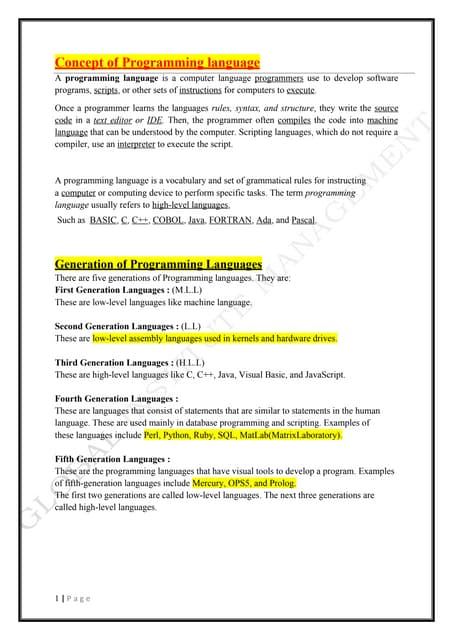Machine language to artificial intelligence
Download as DOC, PDF1 like1,105 views
Programming languages have evolved from machine languages that directly manipulated hardware to higher-level languages that are further abstracted from hardware. First-generation languages used binary, while assembly languages (2GL) introduced symbolic codes. Third-generation languages like C and Fortran are machine-independent and compiled. Fourth-generation languages enhance productivity for tasks like querying, and fifth-generation languages use properties rather than algorithms for artificial intelligence applications like IBM Watson. Understanding which generation a language belongs to provides perspective on the level of control and work required.
1 of 2
Download to read offline

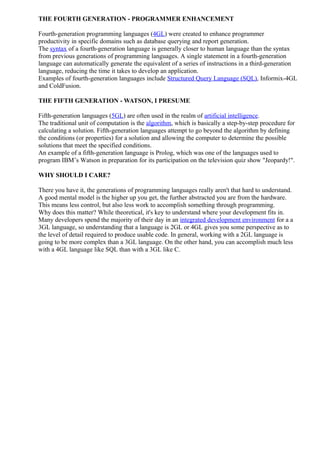
Recommended
Generations Of Programming Languages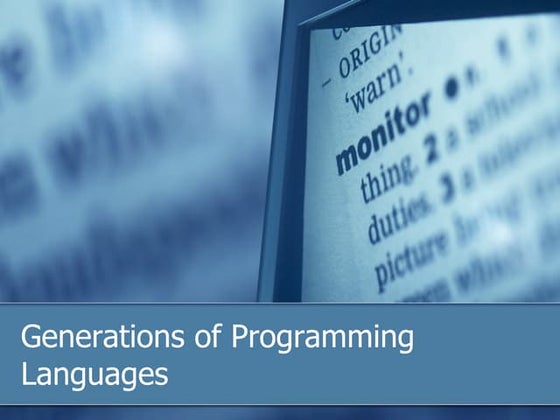



Generations Of Programming Languagespy7rjs
Ěý
There are four generations of programming languages:
1) First generation languages are machine code/binary, the only language computers can understand directly.
2) Second generation languages are assembly languages which provide mnemonics to represent machine code instructions.
3) Third generation languages like Java, C, and Basic are easier for humans to read and write. They are converted into machine code.
4) Fourth generation languages like SQL and Prolog are more focused on problem solving than implementation details. They are very platform independent.Generations of Programming Languages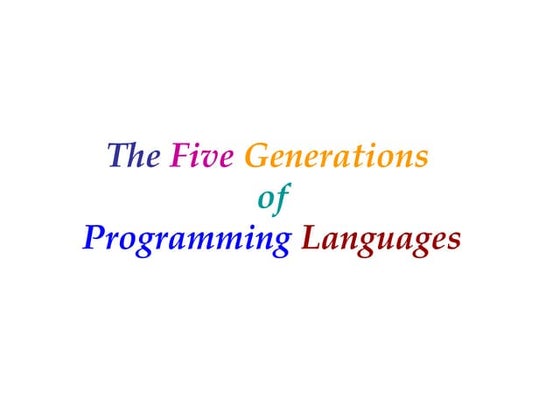



Generations of Programming Languagesjocleph
Ěý
The document outlines the five generations of programming languages, from first generation machine languages that used binary code to second generation assembly languages with mnemonic codes, to third generation high-level languages that introduced data structures and portability, to fourth generation declarative languages that use English-like commands and focus on what needs to be done rather than how, to the current and future fifth generation involving artificial intelligence. Each generation brought improvements like integrated circuits, microprocessors, and graphical development environments. Examples of languages from each generation are provided.Generations of Programming Languages



Generations of Programming LanguagesTarun Sharma
Ěý
Three generations of computer languages are described:
1) Machine and assembly languages (1st and 2nd generation) which use cryptic codes that are translated to machine code.
2) Higher-level languages like FORTRAN, COBOL, BASIC (3rd generation) which use more English-like phrases.
3) Even higher-level languages like Visual Basic and Visual Age (4th generation) which may use graphical tools.
5th generation languages are designed for artificial intelligence problems.Program & language generation



Program & language generationBuxoo Abdullah
Ěý
The document discusses the history of programming languages from first to fifth generation. It defines a program as a set of instructions that tells a computer what to do. First generation languages used binary machine code, while assembly language as a second generation made programming easier by using letters. Third generation high-level languages like FORTRAN, COBOL, and BASIC improved data management and were easier for non-professionals to use. Fourth and fifth generation languages attempted to make programming even more like natural languages through visual interfaces and English-like syntax. generation of programming language



generation of programming languagekunalkumar500
Ěý
The document discusses the history and characteristics of different generations of programming languages. The first generation used machine language, which was complex and error-prone. The second generation introduced assembly language, which was easier to use but still machine-dependent. The third generation saw high-level languages like BASIC, COBOL, FORTRAN and C that had benefits like readability, ease of debugging and lower costs, but provided less hardware control.History of Programming Language



History of Programming Languagetahria123
Ěý
The document discusses the history and evolution of programming languages from the first to fifth generations. It notes that Charles Babbage proposed the first general-purpose computer called the Analytical Engine in 1837 and that Ada Lovelace was the first computer programmer. Programming languages have evolved from machine code consisting of 1s and 0s, to assembly languages using symbolic codes, to modern high-level languages that are closer to human languages like C++, Java, Python and SQL. Fifth generation languages allow solving problems by defining constraints rather than writing algorithms.Generations of programming_language.kum_ari11-1-1-1



Generations of programming_language.kum_ari11-1-1-1lakshmi kumari neelapu
Ěý
This document discusses the generations of programming languages from the 1940s to present and beyond. It covers machine languages from 1940-1956, assembly languages from 1956-1963, high-level languages from 1964-1971, object-oriented programming languages from 1971 to present, and artificial intelligence languages for the present and beyond. Each generation introduced languages that were more user-friendly and abstracted away from the underlying machine compared to previous generations.Presentation on Programming Languages.



Presentation on Programming Languages.Mohammad Shakirul islam
Ěý
A programming language allows people to create programs that instruct machines what to do. There are different levels of programming languages from high-level to low-level. High-level languages like C, C++, Java, HTML and XML are more understandable for programmers as they are further abstracted from hardware. Low-level languages work more closely with hardware and do not require compilation. The document then provides examples of programs in C, Java, HTML and CSS to illustrate these points.Programming languages and paradigms



Programming languages and paradigmsJohn Paul Hallasgo
Ěý
This document discusses different programming language paradigms and generations from machine languages to modern languages. It covers first through fifth generation languages including machine languages, assembly languages, high-level languages, declarative languages, and AI languages. It also covers different programming paradigms like imperative, functional, logic, object-oriented, and concurrent programming and provides examples of languages for each.Programming language



Programming languageAyesha Waheed
Ěý
The document identifies and provides examples of different generations of programming languages. It discusses machine language as the 1st generation language, assembly language as the 2nd generation language, procedural languages like COBOL and Pascal as 3rd generation languages, SQL and FOCUS as 4th generation non-procedural languages that access databases, and Prolog and Mercury as 5th generation natural languages with visual programming environments. Each generation builds upon the prior by making the languages more human-readable and easier to use.Assignment on basic programming language



Assignment on basic programming languageGuru buying house , Main branch ,Barishal.
Ěý
The document discusses the BASIC programming language. It was one of the earliest high-level programming languages developed in the 1960s. It was designed to be simple and easy to learn, making it popular among non-experts. The language includes English keywords like INPUT and PRINT to make it accessible to those without programming experience. It has been widely used in business applications and helped launch the personal computer revolution.Programming language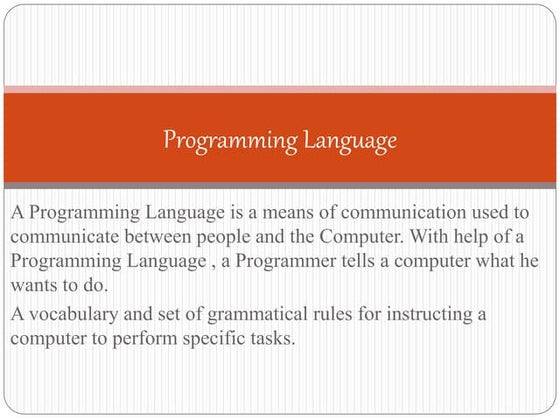



Programming languageShuja Qais
Ěý
The document discusses programming languages and their evolution. It begins by explaining that a programming language allows communication between humans and computers by telling computers what tasks to perform. It then summarizes the main types of programming languages:
1) Machine language uses binary and is directly understood by computers but is difficult for humans.
2) Assembly language uses mnemonics to make machine language more readable for programmers.
3) High-level languages use words and concepts familiar to humans, making programming accessible to non-experts. However, programs must be translated before computers can execute them.
4) Fourth generation languages provide even more human-friendly features like built-in database support.Basic Meaning of Computer languages



Basic Meaning of Computer languagesAmity University | FMS - DU | IMT | Stratford University | KKMI International Institute | AIMA | DTU
Ěý
Language,
Low-level languages,
High-level languages,
CHARACTERSTICS OF LOW LEVEL LANGUAGES
Third generation languages (3GL)
Types: - C++
VISUAL BASIC
JAVA
JAVASCRIPT
Programming language design and implemenation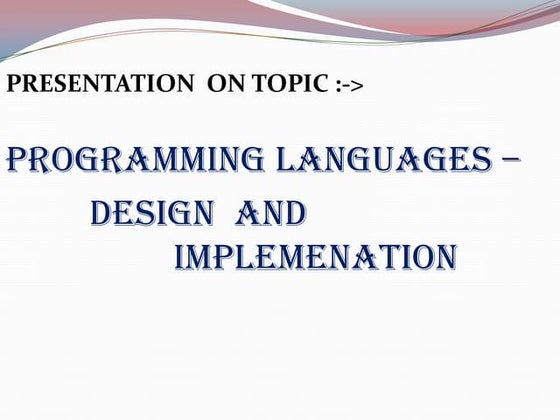



Programming language design and implemenationAshwini Awatare
Ěý
The document discusses key topics in programming language design and implementation including:
1. The importance of studying programming languages to improve problem solving skills, learn new languages, and understand language design.
2. An overview of different programming paradigms like imperative, functional, object-oriented, and logic-based languages.
3. Factors that influence language design like software architectures, programming environments, internationalization needs, and standardization.So you want to be a programmer



So you want to be a programmerBusayo Oyebisi
Ěý
The document provides an introduction to programming, discussing what programming is, common myths, how to get started, choosing a language, necessary tools, the importance of writing code, collaborating with other programmers, and concluding that making mistakes is how one becomes clever in programming. It outlines fundamental concepts to understand like algorithms and data structures, recommends starting with a desktop, web, or mobile language like Java, C#, PHP, or C++, and emphasizes the importance of writing and debugging code as the best way to learn.Basic programming concepts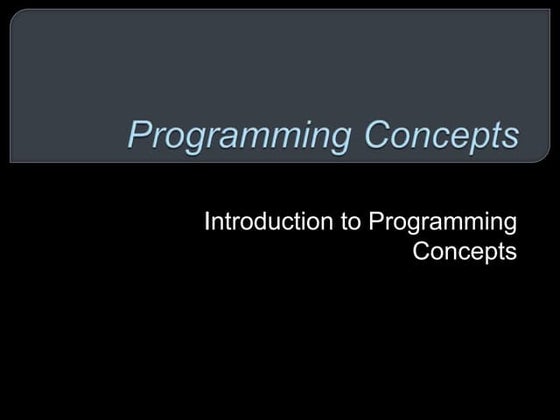



Basic programming conceptssalmankhan570
Ěý
This document discusses the evolution of programming languages from early machine languages to modern higher-level languages. It begins with an introduction to human and computer languages. It then covers the development of machine languages, assembly languages, and higher-level languages like FORTRAN and COBOL. The document discusses the advantages of each generation of languages and examples of languages from the 1950s to modern times.Programming Languages



Programming LanguagesAmity University | FMS - DU | IMT | Stratford University | KKMI International Institute | AIMA | DTU
Ěý
Programming Languages
A formal language for describing computation?
A “user interface” to a computer?
Syntax + semantics?
Compiler, or interpreter, or translator?
A tool to support a programming paradigm?
ICT, Importance of programming and programming languages



ICT, Importance of programming and programming languagesEbin Robinson
Ěý
This document discusses the importance of programming and programming languages. It provides definitions of computer programming and what programming languages are used for. It discusses why data types are important in programming languages. It also provides examples of popular software including Java, Android KitKat, and iOS.Computer programming languages



Computer programming languagesSubramanianMuthusamy3
Ěý
The document discusses different types of computer programming languages including low-level languages like machine language and assembly language that are closer to hardware, and high-level languages like C++, Java, and Python that are easier for humans to read and write. It also covers basic programming concepts like variables, strings, statements, operators, and operands.History of programming



History of programmingSharwin Calimlim
Ěý
The document provides background information on programming languages and their history. It discusses early pioneers in computer programming such as Ada Lovelace, Herman Hollerith, and Konrad Zuse. It outlines the development of many popular modern programming languages such as Fortran, COBOL, BASIC, Pascal, C, C++, Java, PHP, JavaScript, Python, Ruby, and others, describing their key features and common uses. Ada Lovelace is noted as creating the first computer program in 1843 for Charles Babbage's analytical engine.Computer languages



Computer languagesmrutherfordwest
Ěý
A computer language is used to write programs that solve problems, and can be either graphical or text-based, producing source code. Open source software makes the source code publicly available for free collaboration, while proprietary software privately owns the source code and releases only finished products for sale. Machine language uses binary digits understood by computers, and questions ask about advantages and disadvantages of open source software.Programming languages



Programming languagesFatima Abdul Rahman
Ěý
This document provides an overview of several programming languages including machine language, assembly language, high-level languages like FORTRAN, ALGOL, LISP, COBOL, BASIC, Pascal, ADA, SQL, Smalltalk, C, C++, C#, Python and Java. It describes the purpose and key features of each language such as their level of abstraction, syntax, data structures, and application.Grade 10 introduction and history of programming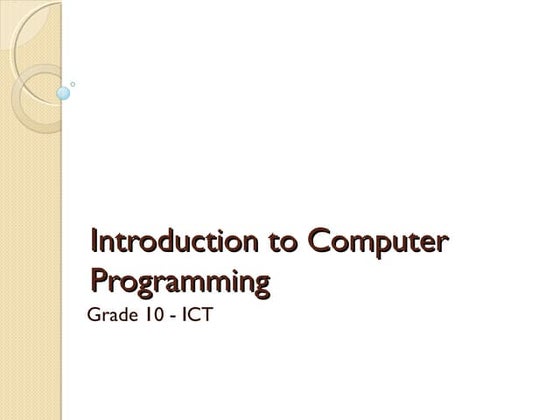



Grade 10 introduction and history of programmingRafael Balderosa
Ěý
Computer programming involves writing instructions to enable computers to perform processes. Programming languages allow humans to communicate with computers through specific sets of words, symbols, and codes. Some of the earliest programming languages included FORTRAN, COBOL, ALGOL, BASIC, PL/1, Pascal, and C. Many modern languages like C++, Java, and Visual Basic were influenced by these early languages and were created to serve different purposes like systems programming, business applications, and building graphical user interfaces.Programming



Programmingabdulkareem_nm
Ěý
This document discusses programming languages and provides examples of popular languages like C++, Java, PHP, and Python. It notes that programming languages and natural languages both have syntax and semantics to facilitate communication and have a basic composition. Assembly language corresponds directly to a computer's machine code instructions. The document also lists some online coding academies and describes Fortran as a numeric-focused language used widely in scientific computing. It concludes with a brief description of computer programmers' typical job responsibilities like coding, debugging, and testing.Concept of computer programming iv



Concept of computer programming ivEyelean xilef
Ěý
The document discusses programming concepts like what a program is, different types of programming languages, the software development process, and object-oriented analysis and design using UML. It specifically defines a program as a set of instructions given to a computer, explains low-level languages like machine language and assembly language versus high-level languages, and outlines the typical phases of software development like analysis, design, coding, testing, and maintenance.Types Of Coding Languages: A Complete Guide To Master Programming



Types Of Coding Languages: A Complete Guide To Master Programmingcalltutors
Ěý
Are you confused about types of coding languages? In this article, we have discussed everything about different types of programming languages in detail.Evolution of programming languages



Evolution of programming languagesNitin Kumar Kashyap
Ěý
The document discusses the evolution of several programming languages from BCPL to Python. It describes how BCPL was developed in 1967 and influenced the creation of the B language in 1970. The B language then influenced the development of C in 1972. The document outlines the major versions of C and C++ and describes how Java was influenced by C and C++. Finally, it discusses the origins and evolution of Python from 1991 onward.Programming Fundamental Presentation



Programming Fundamental Presentationfazli khaliq
Ěý
This presentation for the introduction of Programming languages
i.e High level language, Middle level language and Low level Language.Computer languages 11



Computer languages 11Muhammad Ramzan
Ěý
Computer languages allow humans to communicate with computers through programming. There are different types of computer languages at different levels of abstraction from machine language up to high-level languages. High-level languages are closer to human language while low-level languages are closer to machine-readable code. Programs written in high-level languages require compilers or interpreters to convert them to machine-readable code that can be executed by computers.More Related Content
What's hot (20)
Programming languages and paradigms



Programming languages and paradigmsJohn Paul Hallasgo
Ěý
This document discusses different programming language paradigms and generations from machine languages to modern languages. It covers first through fifth generation languages including machine languages, assembly languages, high-level languages, declarative languages, and AI languages. It also covers different programming paradigms like imperative, functional, logic, object-oriented, and concurrent programming and provides examples of languages for each.Programming language



Programming languageAyesha Waheed
Ěý
The document identifies and provides examples of different generations of programming languages. It discusses machine language as the 1st generation language, assembly language as the 2nd generation language, procedural languages like COBOL and Pascal as 3rd generation languages, SQL and FOCUS as 4th generation non-procedural languages that access databases, and Prolog and Mercury as 5th generation natural languages with visual programming environments. Each generation builds upon the prior by making the languages more human-readable and easier to use.Assignment on basic programming language



Assignment on basic programming languageGuru buying house , Main branch ,Barishal.
Ěý
The document discusses the BASIC programming language. It was one of the earliest high-level programming languages developed in the 1960s. It was designed to be simple and easy to learn, making it popular among non-experts. The language includes English keywords like INPUT and PRINT to make it accessible to those without programming experience. It has been widely used in business applications and helped launch the personal computer revolution.Programming language



Programming languageShuja Qais
Ěý
The document discusses programming languages and their evolution. It begins by explaining that a programming language allows communication between humans and computers by telling computers what tasks to perform. It then summarizes the main types of programming languages:
1) Machine language uses binary and is directly understood by computers but is difficult for humans.
2) Assembly language uses mnemonics to make machine language more readable for programmers.
3) High-level languages use words and concepts familiar to humans, making programming accessible to non-experts. However, programs must be translated before computers can execute them.
4) Fourth generation languages provide even more human-friendly features like built-in database support.Basic Meaning of Computer languages



Basic Meaning of Computer languagesAmity University | FMS - DU | IMT | Stratford University | KKMI International Institute | AIMA | DTU
Ěý
Language,
Low-level languages,
High-level languages,
CHARACTERSTICS OF LOW LEVEL LANGUAGES
Third generation languages (3GL)
Types: - C++
VISUAL BASIC
JAVA
JAVASCRIPT
Programming language design and implemenation



Programming language design and implemenationAshwini Awatare
Ěý
The document discusses key topics in programming language design and implementation including:
1. The importance of studying programming languages to improve problem solving skills, learn new languages, and understand language design.
2. An overview of different programming paradigms like imperative, functional, object-oriented, and logic-based languages.
3. Factors that influence language design like software architectures, programming environments, internationalization needs, and standardization.So you want to be a programmer



So you want to be a programmerBusayo Oyebisi
Ěý
The document provides an introduction to programming, discussing what programming is, common myths, how to get started, choosing a language, necessary tools, the importance of writing code, collaborating with other programmers, and concluding that making mistakes is how one becomes clever in programming. It outlines fundamental concepts to understand like algorithms and data structures, recommends starting with a desktop, web, or mobile language like Java, C#, PHP, or C++, and emphasizes the importance of writing and debugging code as the best way to learn.Basic programming concepts



Basic programming conceptssalmankhan570
Ěý
This document discusses the evolution of programming languages from early machine languages to modern higher-level languages. It begins with an introduction to human and computer languages. It then covers the development of machine languages, assembly languages, and higher-level languages like FORTRAN and COBOL. The document discusses the advantages of each generation of languages and examples of languages from the 1950s to modern times.Programming Languages



Programming LanguagesAmity University | FMS - DU | IMT | Stratford University | KKMI International Institute | AIMA | DTU
Ěý
Programming Languages
A formal language for describing computation?
A “user interface” to a computer?
Syntax + semantics?
Compiler, or interpreter, or translator?
A tool to support a programming paradigm?
ICT, Importance of programming and programming languages



ICT, Importance of programming and programming languagesEbin Robinson
Ěý
This document discusses the importance of programming and programming languages. It provides definitions of computer programming and what programming languages are used for. It discusses why data types are important in programming languages. It also provides examples of popular software including Java, Android KitKat, and iOS.Computer programming languages



Computer programming languagesSubramanianMuthusamy3
Ěý
The document discusses different types of computer programming languages including low-level languages like machine language and assembly language that are closer to hardware, and high-level languages like C++, Java, and Python that are easier for humans to read and write. It also covers basic programming concepts like variables, strings, statements, operators, and operands.History of programming



History of programmingSharwin Calimlim
Ěý
The document provides background information on programming languages and their history. It discusses early pioneers in computer programming such as Ada Lovelace, Herman Hollerith, and Konrad Zuse. It outlines the development of many popular modern programming languages such as Fortran, COBOL, BASIC, Pascal, C, C++, Java, PHP, JavaScript, Python, Ruby, and others, describing their key features and common uses. Ada Lovelace is noted as creating the first computer program in 1843 for Charles Babbage's analytical engine.Computer languages



Computer languagesmrutherfordwest
Ěý
A computer language is used to write programs that solve problems, and can be either graphical or text-based, producing source code. Open source software makes the source code publicly available for free collaboration, while proprietary software privately owns the source code and releases only finished products for sale. Machine language uses binary digits understood by computers, and questions ask about advantages and disadvantages of open source software.Programming languages



Programming languagesFatima Abdul Rahman
Ěý
This document provides an overview of several programming languages including machine language, assembly language, high-level languages like FORTRAN, ALGOL, LISP, COBOL, BASIC, Pascal, ADA, SQL, Smalltalk, C, C++, C#, Python and Java. It describes the purpose and key features of each language such as their level of abstraction, syntax, data structures, and application.Grade 10 introduction and history of programming



Grade 10 introduction and history of programmingRafael Balderosa
Ěý
Computer programming involves writing instructions to enable computers to perform processes. Programming languages allow humans to communicate with computers through specific sets of words, symbols, and codes. Some of the earliest programming languages included FORTRAN, COBOL, ALGOL, BASIC, PL/1, Pascal, and C. Many modern languages like C++, Java, and Visual Basic were influenced by these early languages and were created to serve different purposes like systems programming, business applications, and building graphical user interfaces.Programming



Programmingabdulkareem_nm
Ěý
This document discusses programming languages and provides examples of popular languages like C++, Java, PHP, and Python. It notes that programming languages and natural languages both have syntax and semantics to facilitate communication and have a basic composition. Assembly language corresponds directly to a computer's machine code instructions. The document also lists some online coding academies and describes Fortran as a numeric-focused language used widely in scientific computing. It concludes with a brief description of computer programmers' typical job responsibilities like coding, debugging, and testing.Concept of computer programming iv



Concept of computer programming ivEyelean xilef
Ěý
The document discusses programming concepts like what a program is, different types of programming languages, the software development process, and object-oriented analysis and design using UML. It specifically defines a program as a set of instructions given to a computer, explains low-level languages like machine language and assembly language versus high-level languages, and outlines the typical phases of software development like analysis, design, coding, testing, and maintenance.Types Of Coding Languages: A Complete Guide To Master Programming



Types Of Coding Languages: A Complete Guide To Master Programmingcalltutors
Ěý
Are you confused about types of coding languages? In this article, we have discussed everything about different types of programming languages in detail.Evolution of programming languages



Evolution of programming languagesNitin Kumar Kashyap
Ěý
The document discusses the evolution of several programming languages from BCPL to Python. It describes how BCPL was developed in 1967 and influenced the creation of the B language in 1970. The B language then influenced the development of C in 1972. The document outlines the major versions of C and C++ and describes how Java was influenced by C and C++. Finally, it discusses the origins and evolution of Python from 1991 onward.Programming Fundamental Presentation



Programming Fundamental Presentationfazli khaliq
Ěý
This presentation for the introduction of Programming languages
i.e High level language, Middle level language and Low level Language.Basic Meaning of Computer languages



Basic Meaning of Computer languagesAmity University | FMS - DU | IMT | Stratford University | KKMI International Institute | AIMA | DTU
Ěý
Similar to Machine language to artificial intelligence (20)
Computer languages 11



Computer languages 11Muhammad Ramzan
Ěý
Computer languages allow humans to communicate with computers through programming. There are different types of computer languages at different levels of abstraction from machine language up to high-level languages. High-level languages are closer to human language while low-level languages are closer to machine-readable code. Programs written in high-level languages require compilers or interpreters to convert them to machine-readable code that can be executed by computers.Notacd071



Notacd071cikgushaharizan
Ěý
This document provides an overview of basic programming concepts through 11 lessons. It begins by defining what a program and programming are, and explains that a program contains variables and statements that direct a computer. It then discusses programming languages, generations of programming languages from machine code to visual languages, and programming approaches like structured and object-oriented programming. Other topics covered include translators like compilers and interpreters, how to install Visual Basic 6.0, basic programming elements, operators, data types, pseudocode, and flowcharts. The document aims to introduce foundational programming concepts for beginners in a structured manner through examples and explanations.Notacd07



Notacd07Azmiah Mahmud
Ěý
This document provides an introduction to basic programming concepts including programs, programming, programming languages, and careers in programming.
A program is a series of organized instructions that directs a computer to perform tasks. Programming involves creating a set of commands that direct a computer. Programming languages allow humans to communicate with computers through using words, symbols, and codes. There are many programming languages with different rules. Careers in programming include programmer, programmer analyst, computer scientist, and software engineer.Nota programming



Nota programmingAzmiah Mahmud
Ěý
This document provides an introduction to basic programming concepts including programs, programming, programming languages, and careers in programming.
A program is a series of organized instructions that directs a computer to perform tasks. Programming involves creating a set of commands that direct a computer. Programming languages allow humans to communicate with computers through words, symbols, and codes. There are many programming languages with different rules. Careers in programming include programmer, programmer analyst, computer scientist, and software engineer.Generation of computer languages



Generation of computer languageskitturashmikittu
Ěý
There are three main categories of programming languages: machine languages, assembly languages, and higher-level languages. Higher-level languages are divided into five generations - third being the first true English-like languages, fourth allowing visual programming, and fifth hypothetically using artificial intelligence. The software development life cycle has five phases - needs analysis, program design, development, implementation, and maintenance.Introduction to programming principles languages



Introduction to programming principles languagesFrankie Jones
Ěý
Explain the basic computer and programming fundamentals with appropriate examples of language and technology.Programming Part 01



Programming Part 01zakri zakaria
Ěý
This document provides an introduction to basic programming concepts including programs, programming, programming languages, generations of programming languages, and translators.
The key points covered are:
1) A program is a series of organized instructions that direct a computer to perform tasks. Programming is the creation of a set of commands that direct a computer to carry out a task.
2) Programming languages allow humans to communicate with computers. Examples of programming languages mentioned include BASIC, Pascal, C, and Smalltalk.
3) Programming languages have evolved through generations from machine language (1st generation) to assembly language (2nd generation) to high-level languages like BASIC, Pascal, and C (3La5 ict-topic-5-programming



La5 ict-topic-5-programmingAzmiah Mahmud
Ěý
This document provides an overview of programming and programming languages through a series of lessons:
1. It defines what a program and programming are, and compares a program to a recipe.
2. It discusses different generations of programming languages from machine language to modern languages like C++, and the roles of compilers, interpreters, and assemblers.
3. It covers structured and object-oriented programming approaches, pseudo code, basic programming elements like variables and data types, and mathematical and logical operators.
4. It provides examples of programming languages like Visual Basic and how to install Visual Basic 6.0.Ict topic 5



Ict topic 5kwongliik
Ěý
The document provides an overview of programming concepts including programs, programming languages, translators, generations of programming languages, basic elements in programming, and pseudo code. It defines key terms like program, programming, constants, variables, data types, operators, control structures, assemblers, interpreters, compilers, structured programming, and object-oriented programming. Examples are given for different programming languages, data types, operators, and a pseudo code program. The document is intended as part of an educational lesson on basic programming concepts.Programming languages



Programming languagesvito_carleone
Ěý
This document discusses different types of programming languages:
- Low-level languages like assembly are close to machine instructions and require knowledge of computer hardware. High-level languages abstract programming concepts and are easier for humans.
- Third-generation languages like FORTRAN and COBOL are machine-independent but still textual. Fourth-generation languages allow visual programming.
- Fifth-generation languages are designed for artificial intelligence and problem-solving.Ayushi



AyushiAyushi Chaturvedi
Ěý
The document discusses different types of computer programming languages including machine language, assembly language, high-level languages, and object-oriented programming. It provides examples of some specific programming languages such as BASIC, HTML, Java, C++, FORTH, and LOGO. It also discusses key computer science concepts related to programming languages such as interpreted languages, compiled languages, authoring languages, and machine code.Generation of Computer language by arya dutta (1).pptx



Generation of Computer language by arya dutta (1).pptxAryaDutta4
Ěý
This ppt is make by a school student of class 11 studying computer science to help others in there school project.
thank you :DLa 5 Programming2



La 5 Programming2Cma Mohd
Ěý
The document discusses the generations of programming languages. It identifies the five generations as:
1) First generation: Machine language using binary code.
2) Second generation: Assembly language using mnemonics to represent machine code.
3) Third generation: High-level procedural languages like Pascal, FORTRAN, and C that are closer to human language.
4) Fourth generation: Non-procedural languages focused on accessing databases, like SQL.
5) Fifth generation: Natural languages that allow visual or spoken interaction with computers.introduction to programming languages



introduction to programming languagesNaqashAhmad14
Ěý
The document provides an introduction to programming languages. It discusses the different levels of programming languages including low-level languages like machine language and assembly language that are close to hardware, and high-level languages like C++, Java, and Python that are more abstract. It also covers procedural languages which specify steps to complete tasks and object-oriented languages which model real-world objects. Examples are given of popular languages from each paradigm like C, Pascal, and PHP for procedural and C++, Java, Ruby for object-oriented.Preliminary-Examination.docx



Preliminary-Examination.docxStromilesVidal
Ěý
1. The document provides information about a test taken by Stromiles Dira Vidal on September 24, 2022. The test covers topics like programming language generations, computer hardware, and software development.
2. The test consists of multiple choice, true/false, enumeration, and essay questions testing knowledge of programming language concepts and computer science principles.
3. Vidal's responses demonstrate understanding of topics like the characteristics of different programming language generations, the roles of computer components, and how programming languages have evolved over time to be more user-friendly and efficient.What is Assembly & Procedural Programming Languages?



What is Assembly & Procedural Programming Languages?MinoshWijayarathne
Ěý
What is Assembly & Procedural Programming Languages?
A low-level programming language is a programming language that provides little or no abstraction from computer’s microprocessor.
A high-level programming language is a programming language that is more abstract, easier to use, and more portable across platforms.
Lang generations 7557_syed_ghazanfarnaqvi_saturday



Lang generations 7557_syed_ghazanfarnaqvi_saturdaySyed Naqvi
Ěý
The document discusses the history and generations of programming languages from the first to fifth generations. It provides details on the characteristics of each generation's languages, including that first generation languages used machine code, second generation used assembly languages, third generation were high-level imperative languages like FORTRAN and COBOL, fourth generation added object-orientation, and fifth generation focused on logic and knowledge-based languages. It also covers the basics of object-oriented programming and how objects contain both data and methods.More from Suneel Dogra (20)
Business model



Business modelSuneel Dogra
Ěý
The document defines business models and their key components. It discusses traditional business models and e-commerce models. For business models, it identifies the main components as the value proposition, target customers, distribution channels, customer relationships, revenue streams, resources, activities, and cost structure. For e-commerce models, it provides examples of revenue streams like advertising, subscriptions, transactions, and sales. It also discusses the value proposition, target market segments, competitive environment, market strategy, and customer relationship management as important components of e-commerce models.Internet



InternetSuneel Dogra
Ěý
This document provides an overview of the Internet, including its history and evolution from ARPANET, networking models like OSI and TCP/IP, packet switching, methods of Internet access such as dial-up, ISP services, and protocols used on the Internet like HTTP, SMTP, FTP and others. It describes the layers of the OSI model and TCP/IP stack and classifies networks as LAN, MAN and WAN based on geographical range.Html



HtmlSuneel Dogra
Ěý
This document provides an introduction to HTML (Hypertext Markup Language). It describes what HTML is, discusses some basic HTML tags like <HTML>, <HEAD>, <TITLE>, and <BODY>, and how they are used to structure an HTML page. It also covers formatting text with headers, fonts, and other tags. The document concludes with a brief discussion of images and the Dreamweaver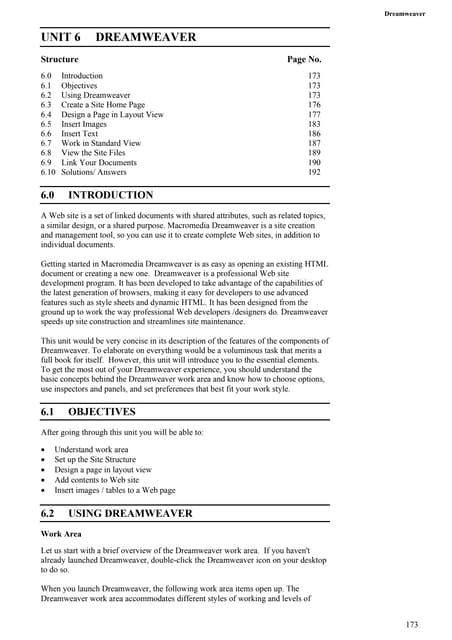



DreamweaverSuneel Dogra
Ěý
This document provides instructions for using Dreamweaver to create a basic website. It describes setting up the site structure, creating a home page, designing pages in Layout View by drawing cells and tables, and adding images and text. Key steps include saving documents in the designated site folder, defining the page title, laying out the page design in cells and tables similarly to a sample layout, and inserting content like images and text into the layout.Advanced html



Advanced htmlSuneel Dogra
Ěý
The document discusses advanced HTML features for creating interactive web pages, including links, lists, tables, frames, forms, and other special tags. It provides details on how to use the <A>, <UL>, <OL>, <DL>, <TABLE>, <TR>, <TD>, <FORM>, and other tags to add these features. Examples are given of code for each tag type to demonstrate their proper usage.File organisation



File organisationSuneel Dogra
Ěý
This document discusses different file organization techniques for conventional database management systems. It describes sequential file organization where records are stored consecutively. Indexed sequential file organization is introduced to improve query response time for sequential files by adding an index. Direct file organization and multi-key file organization are also mentioned, which allow accessing records using different keys. Trade-offs among these techniques are discussed.Distributed databases



Distributed databasesSuneel Dogra
Ěý
This document discusses distributed databases. It begins by introducing distributed database systems and their structure. Key points include that the database is split across multiple computers that communicate over a network. It then discusses the tradeoffs of distributing a database, such as increased availability but also higher complexity. The document outlines two approaches to distributing data - replication, where copies of data are stored at different sites, and fragmentation, where relations are split into pieces stored at different sites. It provides examples to illustrate these concepts.Data base management system



Data base management systemSuneel Dogra
Ěý
This document introduces the basic concepts of database management systems. It discusses the limitations of traditional file-oriented approaches and the motivation for adopting a database approach. The key aspects covered include the three views of data (logical, conceptual, physical), the components of a DBMS, and the advantages and disadvantages of using a DBMS. It provides an overview of important database concepts such as entities, attributes, schemas, and data dictionaries.Web sitedesignpart1



Web sitedesignpart1Suneel Dogra
Ěý
The document outlines the process for effective website design, including analyzing the content and target audience, organizing the navigation, content, page layout and design, developing the web page and site layout as well as graphics, and implementing the site by checking user interaction, uploading the site, and fine tuning. It also defines a website as an online location containing web pages that serves as a personal connection to the world, and notes that website design is different from other forms of publishing or communication.Web sitedesignpart1



Web sitedesignpart1Suneel Dogra
Ěý
The document outlines the process for effective website design, including analyzing the content and target audience, organizing the navigation, content, page layout and design, developing the web page and site layout as well as graphics, and implementing the site by checking user interaction, uploading the site, and fine tuning. It also defines what a website is as an online location containing web pages that functions as a personal communication connection, and notes that website design is different from other media.What is the linux



What is the linuxSuneel Dogra
Ěý
Linux is an open-source operating system developed by Linus Torvalds in 1991. It provides a free or low-cost alternative to proprietary operating systems like Windows. Some key differences between Linux and Windows include cost, package management, hardware support, security, reliability, and user interfaces. While Windows prioritizes gaming and has more commercial software available, Linux offers more customization options and is widely used across different device types.He 12 different types of servers that every techie should know about



He 12 different types of servers that every techie should know aboutSuneel Dogra
Ěý
This document lists and describes 12 common types of servers: 1) Real-Time Communication Servers which allow instant messaging, 2) FTP Servers which securely transfer files between computers, 3) Collaboration Servers which enable online collaboration, 4) List Servers which manage mailing lists, 5) Telnet Servers which allow remote computer access and control, 6) Web Servers which serve web pages to browsers, 7) Virtual Servers which share resources among multiple websites, 8) Proxy Servers which act as intermediaries for user requests, 9) Mail Servers which move and store email, 10) Server Platforms which are the underlying operating systems, 11) Open Source Servers which use open source operating systems, and 12Bachelor of computer application b.c.a.-2014



Bachelor of computer application b.c.a.-2014Suneel Dogra
Ěý
This document provides the syllabus for the History and Culture of Punjab course for the Bachelor of Computer Applications program. It outlines the course content, examination structure, evaluation criteria and suggested reading materials. The course will cover the history and culture of Punjab from 1200-1849 AD in four units, examining topics like society under Afghan rule, the rise of Sikhism, the Khalsa period and developments in language and architecture. Students will be evaluated based on their performance in short answer and essay type questions covering the entire syllabus in the three hour examination.Cloud computing application



Cloud computing applicationSuneel Dogra
Ěý
Cloud computing allows users to access shared computing resources over the Internet. It provides hardware, software, storage and services to users on demand. The document discusses several cloud applications including Google Apps (Gmail, Docs), Dropbox, Basecamp, Highrise, Backpack, Campfire, Evernote, Xero, PayCycle, WorkflowMax, Logmein, Carbonite and Springpad that provide file sharing, project management, contact management, personal information management, online accounting, payroll services, time tracking, remote access, online backup and idea saving capabilities to users through the cloud.Fast track to linux



Fast track to linuxSuneel Dogra
Ěý
Ubuntu has become one of the most widely used Linux distributions and helped make Linux accessible for non-technical users. The desktop interfaces for Linux have evolved significantly with options like Gnome and KDE that provide graphical experiences similar to Windows and macOS. Linux is now suitable for general use cases with distributions that are easy to use and provide functionality out of the box. While Linux may not be optimal for gaming or certain professional graphic design workflows, it can be used effectively for regular computing needs like office productivity and is a free, customizable alternative to Windows.A sorted linear array 



A sorted linear array Suneel Dogra
Ěý
This document describes algorithms for inserting and deleting elements from a sorted or unsorted array. The insert sorted algorithm inserts an element into the correct position in a sorted array by shifting elements down. The insert unsorted algorithm inserts an element into a specified location by shifting elements downward. The delete algorithm removes an element from a specified location by shifting elements upward and decrementing the count.String in c



String in cSuneel Dogra
Ěý
A string in C is an array of characters that ends with a null character '\0'. Strings are stored in memory as arrays of characters with the null character added to the end. Common string operations in C include declaring and initializing strings, reading strings from users, and built-in string handling functions like strlen(), strcpy(), strcat(), and strcmp().Machine language to artificial intelligence
- 1. COMPUTER PROGRAMMING: FROM MACHINE LANGUAGE TO ARTIFICIAL INTELLIGENCE Takeaway: As computing power has increased, programming languages have evolved to take advantage of enhanced computing resources. Programming languages were used even before computers were invented. For example, a player piano scroll, that long roll of encoded paper tape, is considered an early form of programming because it contained the instructions needed to make a piano play a tune. The first computers were programmed by flipping switches and changing the configuration of the hardware. As a result, early programmers had to be intimately familiar with computer hardware. But we’ve come a long way, and high-level programming languages require little or no knowledge of the underlying hardware. THE FIRST GENERATION - PROGRAMMING AT THE MACHINE LEVEL First-generation programming languages (1GL) are often known as machine languages or machine code. They operate at the lowest level of abstraction (closest to the hardware) of all languages. First-generation languages deal directly with the binary zeros and ones that are used to store and process information in a computer. Programs in higher-level languages must be compiled or assembled into machine code in order to run. First-generation languages were used to program first- generation computers such as UNIVAC I and the IBM 701. THE SECOND GENERATION - SOME ASSEMBLY REQUIRED Second-generation languages (2GL), often known as assembly languages, were developed largely because of the difficulty in programming with first-generation languages. Although still low-level languages, assembly languages introduced the use of symbolic codes (called mnemonics) to represent instructions to the computer. A program in assembly language is translated into machine code by means of a utility known as an assembler. Since they operate at the lowest level of abstraction, second-generation languages offer the benefits of speed and minimum code size. They also enable a programmer to directly manipulate hardware components such as memory locations and registers. At one time, assembly languages were used to program operating systems and applications that required smaller, faster-running code, such as video games. Examples of games written in assembly language include console games for the Mega Drive/Genesis platform and the Super Nintendo Entertainment System platform. Although largely supplanted by higher-level languages, assembly languages are still used in situations where hardware interaction is required or performance must be optimized. Some compilers for higher-level languages compile source code to an assembly language before invoking an assembler to compile to machine code. THE THIRD GENERATION - GENTLEMAN’S C AND OTHERS The third generation of programming languages (3GL) includes high-level languages such as C, C+ +, Fortran, COBOL, BASIC, C# and Java. Third-generation programming languages represent a major improvement in usability over assembly languages. Unlike assembly languages, third-generation languages are not machine-specific. When programming with a third-generation language, a programmer writes the source code for the program and then uses a compiler to translate it into object code (or machine code), which can be understood by the targeted computer. The development of programming paradigms such as structured programming and object-oriented programming (OOP) coincided with the development of third-generation languages.
- 2. THE FOURTH GENERATION - PROGRAMMER ENHANCEMENT Fourth-generation programming languages (4GL) were created to enhance programmer productivity in specific domains such as database querying and report generation. The syntax of a fourth-generation language is generally closer to human language than the syntax from previous generations of programming languages. A single statement in a fourth-generation language can automatically generate the equivalent of a series of instructions in a third-generation language, reducing the time it takes to develop an application. Examples of fourth-generation languages include Structured Query Language (SQL), Informix-4GL and ColdFusion. THE FIFTH GENERATION - WATSON, I PRESUME Fifth-generation languages (5GL) are often used in the realm of artificial intelligence. The traditional unit of computation is the algorithm, which is basically a step-by-step procedure for calculating a solution. Fifth-generation languages attempt to go beyond the algorithm by defining the conditions (or properties) for a solution and allowing the computer to determine the possible solutions that meet the specified conditions. An example of a fifth-generation language is Prolog, which was one of the languages used to program IBM’s Watson in preparation for its participation on the television quiz show "Jeopardy!". WHY SHOULD I CARE? There you have it, the generations of programming languages really aren't that hard to understand. A good mental model is the higher up you get, the further abstracted you are from the hardware. This means less control, but also less work to accomplish something through programming. Why does this matter? While theoretical, it's key to understand where your development fits in. Many developers spend the majority of their day in an integrated development environment for a a 3GL language, so understanding that a language is 2GL or 4GL gives you some perspective as to the level of detail required to produce usable code. In general, working with a 2GL language is going to be more complex than a 3GL language. On the other hand, you can accomplish much less with a 4GL language like SQL than with a 3GL like C.



